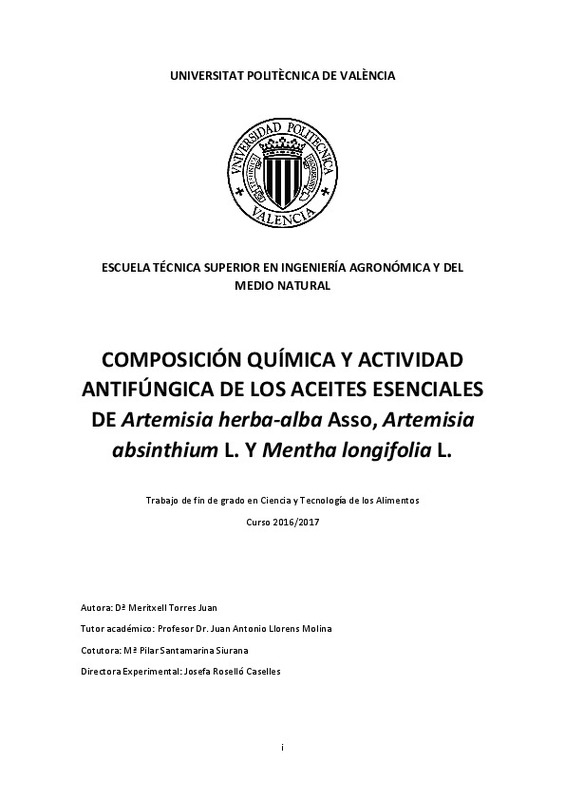|
Resumen:
|
[ES] En este trabajo se evalúa la capacidad antifúngica de los aceites esenciales de A.
absinthium, A. herba-alba y M. longifolia sobre los hongos fitopatógenos y de post-cosecha
Alternaria alternata, Botryotinia fuckeliana, ...[+]
[ES] En este trabajo se evalúa la capacidad antifúngica de los aceites esenciales de A.
absinthium, A. herba-alba y M. longifolia sobre los hongos fitopatógenos y de post-cosecha
Alternaria alternata, Botryotinia fuckeliana, Curvularia hawaiiensis, Epicoccum nigrum,
Fusarium oxysporum lycopersici, Fusarium nygamai, Rhizoctonia solani y Verticillium dahliae,
con el fin de obtener un biofungicida botánico respetuoso con el medioambiente, y de bajo
riesgo.
Los aceites esenciales fueron obtenidos por hidrodestilación de planta cultivada en
parcelas experimentales de la UPV (Artemisia absinthium L y Mentha longifolia L, de
composición conocida) y de una población silvestre de A. herba-alba. En esta última se estudió
la variabilidad química de la población a partir de muestras individuales procesadas mediante
extracción-destilación simultáneas (equipo Likens-Nickerson). El análisis de su composición se
realizó mediante cromatografía de gases, mostrando una clara homogeneidad cualitativa en su
composición química.
La actividad antifúngica “in vitro” de los aceites esenciales se evaluó siguiendo la
metodología de Singh et al., (2008) modificada. Los bioensayos se realizaron a la dosis de 300
μg/mL.
El aceite esencial de la menta (M. longifolia) reveló resultados muy satisfactorios,
mostrando valores de inhibición del crecimiento miceliar (MGI) entre el 40 y 75% en casi todos
los hongos ensayados. A. absinthium mostró efectividad frente a B. fuckeliana, C. hawaiiensis y
R. solani con valores MGI del 50%, siendo este un valor alto. El aceite esencial de A. herba alba
presentó resultados de inhibición del crecimiento miceliar del 30% frente a C. hawaiiensis,
siendo más bajos en los restantes hongos ensayados.
En este estudio se pone de manifiesto el gran potencial del aceite esencial de Mentha
longifolia para el control de los hongos y se muestra como alternativa sólida a los agroquímicos.
[-]
[EN] In this research study, the antifungal potential power of the essential oils of Artemisia
absinthium, Artemisia herba-alba and Mentha longifolia is analysed on the phytopathogenic and
post-harvest fungus Alternaria ...[+]
[EN] In this research study, the antifungal potential power of the essential oils of Artemisia
absinthium, Artemisia herba-alba and Mentha longifolia is analysed on the phytopathogenic and
post-harvest fungus Alternaria alternata, Botryotinia fuckeliana, Curvularia hawaiiensis,
Epicoccum nigrum, Fusarium oxysporum lycopersici, Fusarium nygamai, Rhizoctonia solani and
Verticillium dahliae, in order to obtain an environmentally-friendly and low-risk botanical biofungicide.
The essential oils were obtained by hydrodistillation of cultivated plants coming from
the experimental fields in UPV (Artemisia absinthium L. and Mentha longifolia L., whose
composition were known) and a wild population of A. herba-alba. For this last one, the chemical
variability of population was studied from individual samples which were processed by
simultaneous distillation-extraction (Likens-Nickerson equipment). The chemical analysis was
performed by gas chromatography, showing clearly qualitative homogeneity regarding its
composition.
The "in vitro" antifungal activity of essential oils was assessed following a modified
methodology based on the one designed by Singh et al., (2008). The bioassays were performed
with a dose of 300 μg / mL.
Satisfactory results were obtained from the oil of mint (M. longifolia) showed satisfactory results.
In fact, it shows values of inhibition of mycelial growth (MGI) between 40 and 75% in almost all
the tested fungus. Likewise, A. absinthium was effective against B. fuckeliana, C. hawaiiensis and
R. solani with MGI values of 50%, being it a high value. The essential oil of A. herba-alba
presented 30% inhibition of mycelial growth against C. hawaiiensis, being lower in the remaining
fungus tested.
This study reveals the great potential of the essential oil of Mentha longifolia for the
fungus control, showing it as a solid alternative to agrochemicals.
[-]
|







